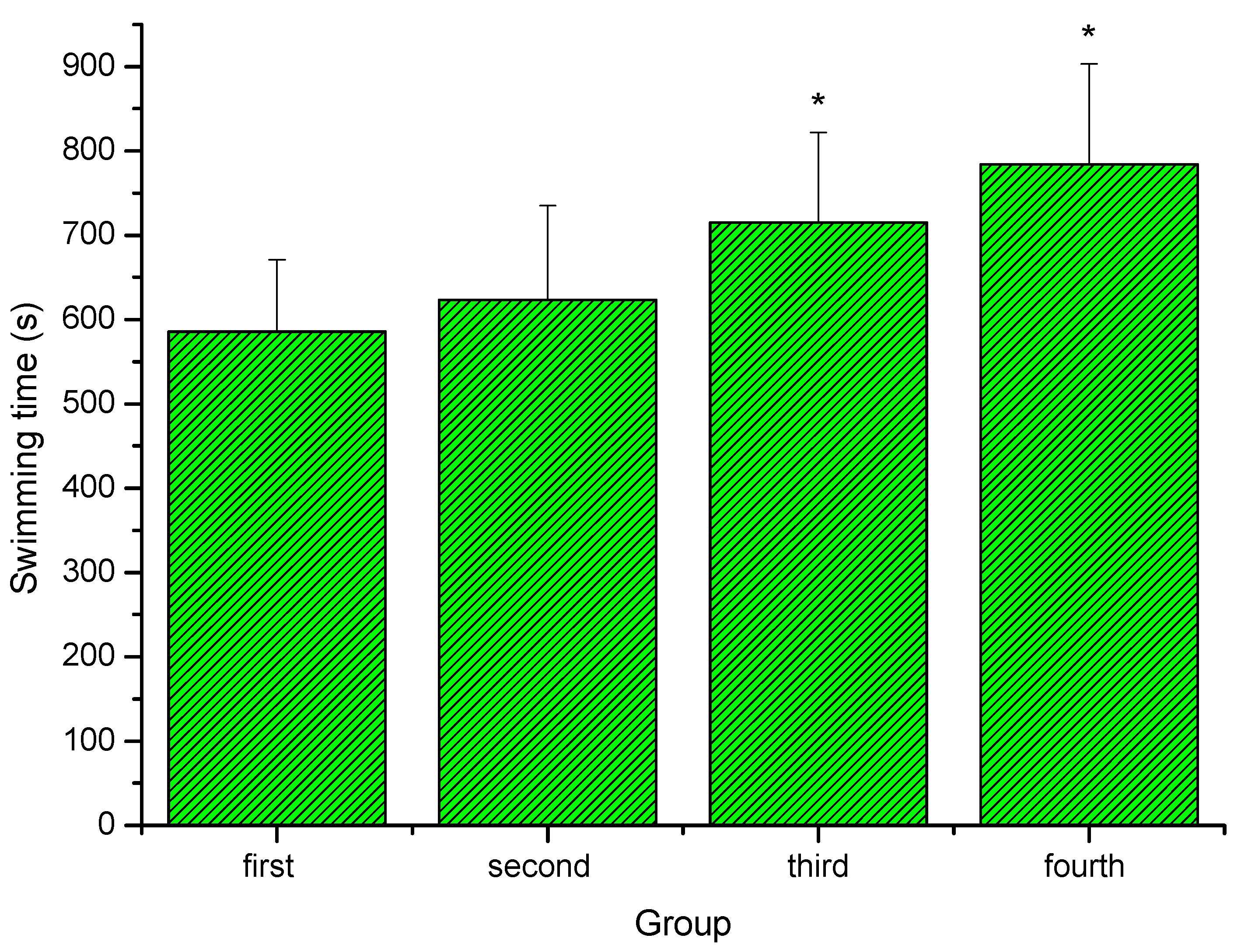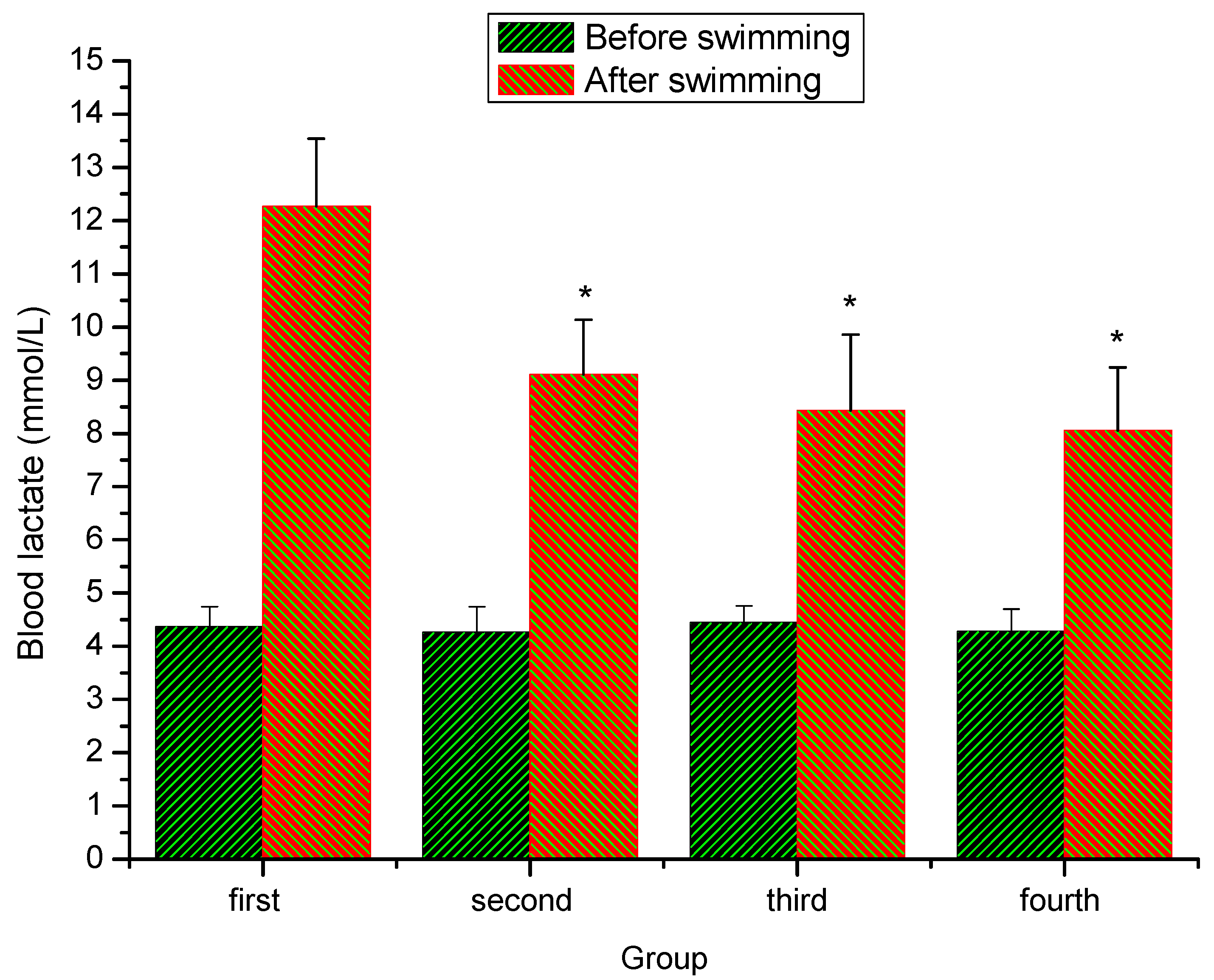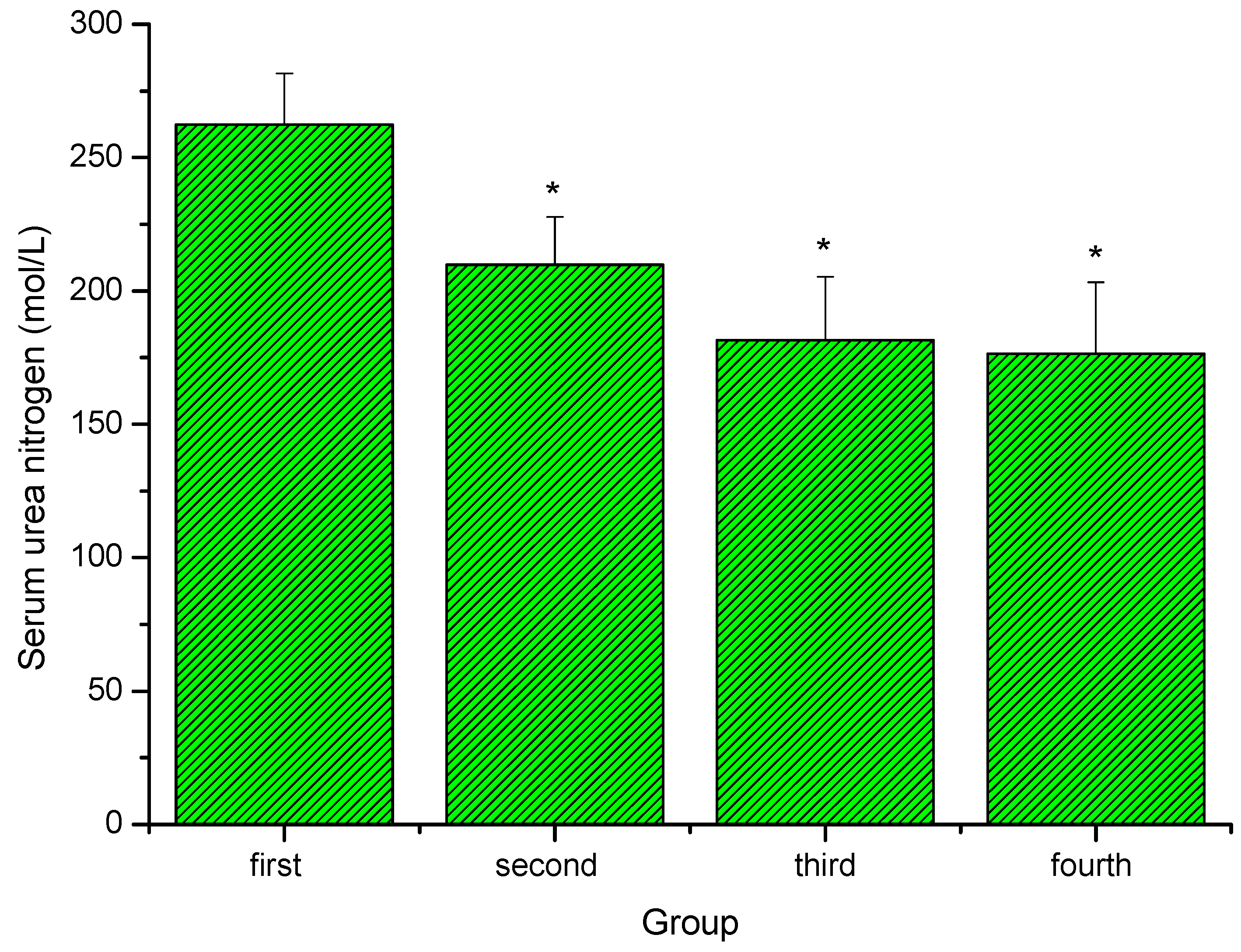Anti-Fatigue Activity of Extracts of Stem Bark from Acanthopanax senticosus
Abstract
:1. Introduction
2. Results and Discussion
2.1. Effect of extracts of stem bark from Acanthopanax senticosus (ASSE) on the body weight of mice
2.2. Effect of extracts of stem bark from Acanthopanax senticosus (ASSE) on swimming time to exhaustion of mice


2.3. Effect of extracts of stem bark from Acanthopanax senticosus (ASSE) on blood lactate of mice

2.4. Effect of extracts of stem bark from Acanthopanax senticosus (ASSE) on serum urea nitrogen (SUN) of mice

2.5. Effect of extracts of stem bark from Acanthopanax senticosus (ASSE) on tissue glycogen of mice
| Group | Tissue glycogen (mg/g) | |
|---|---|---|
| Liver | Muscle | |
| first | 7.81 ± 3.32 | 1.17 ± 0.34 |
| second | 14.29 ± 3.87* | 1.81 ± 0.53* |
| third | 17.22 ± 4.04* | 2.06 ± 0.48* |
| fourth | 18.86 ± 3.79* | 1.97 ± 0.62* |
3. Experimental
3.1. Chemicals
3.2. Plant material and extraction
3.3. Selection of animal and care
3.4. Forced swimming test
3.5. Measurement of blood lactate contents of mice
3.6. Measurement of serum urea nitrogen and tissue glycogen contents of mice
3.7. Statistical analysis
4. Conclusions
References and Notes
- Jung, C.H.; Jung, H.; Shin, Y.C.; Park, J.H.; Jun, C.Y.; Kim, H.M.; Yim, H.S.; Shin, M.G.; Bae, H.S.; Kim, S.H.; Ko, S.G. Eleutherococcus senticosus extract attenuates LPS-induced iNOS expression through the inhibition of Akt and JNK pathways in murine macrophage. J. Ethnopharmacol. 2007, 113, 183–187. [Google Scholar] [Green Version]
- Yoon, T.J.; Yoo, Y.C.; Lee, S.W.; Shin, K.S.; Choi, W.H.; Hwang, S.H.; Ha, E.S.; Jo, S.K.; Kim, S.H.; Park, W.M. Anti-metastatic activity of Acanthopanax senticosus extract and its possible immunological mechanism of action. J. Ethnopharmacol. 2004, 93, 247–253. [Google Scholar] [CrossRef]
- Fujikawa, T.; Kanada, N.; Shimada, A.; Ogata, M.; Suzuki, I.; Hayashi, I.; Nakashima, K. Effect of sesamin in Acanthopanax senticosus HARMS on behavioral dysfunction in rotenone-induced parkinsonian rats. Biol. Pharm. Bull. 2005, 28, 169–172. [Google Scholar]
- Yi, J.M.; Hong, S.H.; Kim, J.H.; Kim, H.K.; Song, H.J.; Kim, H.M. Effect of Acanthopanax senticosus stem on mast cell-dependent anaphylaxis. J. Ethnopharmacol. 2002, 79, 347–352. [Google Scholar] [CrossRef]
- Jung, H.J.; Park, H.J.; Kim, R.G.; Shin, K.M.; Ha, J.; Choi, J.W.; Kim, H.J.; Lee, Y.S.; Lee, K.T. In vivo anti-inflammatory and antinociceptive effects of liriodendrin isolated from the stem bark of Acanthopanax senticosus. Planta Med. 2002, 69, 610–616. [Google Scholar]
- Hibasami, H.; Fujikawa, T.; Takeda, H.; Nishibe, S.; Satoh, T.; Fujisawa, T.; Nakashima, K. Induction of apoptosis by Acanthopanax senticosus HARMS and its component, sesamin in human stomach cancer KATO III cells. Oncol. Rep. 2000, 7, 1213–1216. [Google Scholar]
- Davydov, M.; Krikorian, A.D. Eleutherococcus senticosus (Rupr. & Maxim.) Maxim. (Araliaceae) as an adaptogen: a closer look. J. Ethonopharm. 2000, 72, 345–393. [Google Scholar] [CrossRef]
- Lee, S.; Son, D.; Ryu, J.; Lee, Y.S.; Jung, S.H.; Kang, J.; Lee, S.Y.; Kim, H.S.; Shin, K.H. Anti-oxidant activities of Acanthopanax senticosus stems and their lignan components. Arch. Pharm. Res. 2004, 27, 106–110. [Google Scholar] [CrossRef]
- Li, Q.; Jia, Y.; Xu, L.; Wang, X.; Shen, Z.; Liu, Y.; Bi, K. Simultaneous determination of protocatechuic acid, syringin, chlorogenic acid, caffeic acid, liriodendrin and isofraxidin in Acanthopanax senticosus Harms by HPLC-DAD. Biol. Pharm. Bull. 2006, 29, 532–534. [Google Scholar] [CrossRef]
- Park, H.R.; Park, E.; Rim, A.R.; Jeon, K.; Hwang, J.H.; Lee, S.C. Antioxidant activity of extracts from Acanthopanax senticosus. Afr. J. Biotechnol. 2006, 5, 2388–2396. [Google Scholar]
- Xi, M.; Hai, C.; Tang, H.; Chen, M.; Fang, K.; Liang, X. Antioxidant and antiglycation properties of total saponins extracted from traditional Chinese medicine used to treat diabetes mellitus. Phytother. Res. 2008, 22, 228–237. [Google Scholar] [CrossRef]
- Lin, Q.Y.; Jin, L.J.; Cao, Z.H.; Li, H.Q.; Xu, Y.P. Protective effect of Acanthopanax senticosus extract against endotoxic shock in mice. J. Ethnopharmacol. 2008, 118, 495–502. [Google Scholar] [CrossRef]
- Gandevia, S.C. Spinal and supraspinal factors in human muscle fatigue. Physiol. Rev. 2001, 81, 1725–1789. [Google Scholar]
- Millet, G.Y.; Lepers, R. Alterations of neuromuscular function after prolonged running, cycling and skiing exercises. Sports Med. 2004, 34, 105–116. [Google Scholar] [CrossRef]
- Wang, Z.B.; Yan, B. Gastrodia elata Blume extract ameliorates exercise induced fatigue. Afr. J. Biotechnol. 2010, 9, 5978–5982. [Google Scholar]
- Letafatkar, K.; Alizadeh, M.H.; Kordi, M.R. The Effect of Exhausting Exercise Induced Muscular Fatigue On Functional Stability. J. Soc. Sci. 2009, 5, 416–422. [Google Scholar]
- Tharakan, B.; Dhanasekaran, M.; Manyam, B.V. Antioxidant and DNA protecting properties of anti-fatigue herb Trichopus zeylanicus. Phytother. Res. 2005, 19, 669–673. [Google Scholar] [CrossRef]
- Tang, K.J.; Nie, R.X.; Jing, L.J.; Chen, Q.S. Anti-athletic fatigue activity of saponins (Ginsenosides) from American ginseng (Panax quinquefolium L.). Afr. J. Pharm. Pharmacol. 2009, 3, 301–306. [Google Scholar]
- Jung, K.A.; Han, D.; Kwon, E.K.; Lee, C.H.; Kim, Y.E. Antifatigue effect of Rubus coreanus Miquel extract in mice. J. Med. Food. 2007, 10, 689–693. [Google Scholar] [CrossRef]
- Jung, K.; Kim, I.H.; Han, D. Effect of medicinal plant extracts on forced swimming capacity in mice. J. Ethnopharmacol. 2004, 93, 75–81. [Google Scholar] [CrossRef]
- Ikeuchi, M.; Koyama, T.; Takahashi, J.; Yazawa, K. Effects of astaxanthin supplementation on exercise-induced fatigue in mice. Biol. Pharm. Bull. 2006, 29, 2106–2110. [Google Scholar] [CrossRef]
- Shin, H.Y.; Shin, T.Y.; Seo, S.W.; Na, H.J.; Kwon, Y.T.; Song, B.K.; Lee, E.J.; Kim, Y.K.; Hong, M.C.; Shin, M.K.; Hong, S.H.; Kim, H.M. Decrease of immobility behavior in forced-swimming test and immune system enhancing effect of traditional medicine Gamisipjundaebo-tang. Pharmacol. Biochem. Behav. 2004, 79, 253–259. [Google Scholar] [CrossRef]
- Mizunoya, W.; Oyaizu, S.; Ishihara, K.; Fushiki, T. Protocol for measuring the endurance capacity of mice in an adjustable-current swimming pool. Biosci. Biotechnol. Biochem. 2002, 66, 1133–1136. [Google Scholar] [CrossRef]
- Feng, H.; Ma, H.B.; Lin, H.Y.; Putheti, R. Antifatigue activity of water extracts of Toona sinensis Roemor leaf and exercise-related changes in lipid peroxidation in endurance exercis. J. Med. Plants Res. 2009, 3, 949–954. [Google Scholar]
- Ma, L.; Cai, D.L.; Li, H.X.; Tong, B.D.; Song, L.H.; Wang, Y. Anti-fatigue effects of salidroside in mice. J. Med. Coll. PLA. 2008, 23, 88–93. [Google Scholar] [CrossRef]
- Gleeson, N.; Eston, R.; Marginson, V.; McHugh, M. Effects of prior concentric training on eccentric exercise induced muscle damage. Br. J. Sports Med. 2003, 37, 119–125. [Google Scholar] [CrossRef]
- Cairns, S.P. Lactic acid and exercise performance: culprit or friend? Sports Med. 2006, 36, 279–291. [Google Scholar] [CrossRef]
- Wu, J.L.; Wu, QP.; Huang, J.M.; Chen, R.; Cai, M.; Tan, J.B. Effects of L-malate on physical stamina and activities of enzymes related to the malate-aspartate shuttle in liver of mice. Physiol. Res. 2007, 56, 213–220. [Google Scholar]
- Shang, H.P.; Cao, S.H.; Wang, J.H.; Zheng, H.; Putheti, R. Glabridin from Chinese herb licorice inhibits fatigue in mice. Afr. J. Trad. CAM 2010, 7, 17–23. [Google Scholar]
- Koo, H.N.; Lee, J.K.; Hong, S.H.; Kim, H.M. Herbkines increases physical stamina in mice. Biol. Pharm. Bull. 2004, 27, 117–119. [Google Scholar] [CrossRef]
- Suh, S.H.; Paik, I.Y.; Jacobs, K. Regulation of blood glucose homeostasis during prolonged exercise. Mol. Cells 2007, 23, 272–279. [Google Scholar]
- Yu, B.; Lu, Z.X.; Bie, X.M.; Lu, F.X.; Huang, X.Q. cavenging and anti- fatigue activity of fermented defatted soybean peptides. Eur. Food Res. Technol. 2008, 226, 415–421. [Google Scholar] [CrossRef]
- Nozawa, Y.; Yamada, K.; Okabe, Y.; Ishizaki, T.; Kuroda, M. The anti-fatigue effects of the low-molecular-weight fraction of bonito extract in mice. Biol. Pharm. Bull. 2009, 32, 468–474. [Google Scholar] [CrossRef]
- Kim, K.M.; Yu, K.W.; Kang, D.H.; Koh, J.H.; Hong, B.S.; Suh, H.J. Anti-stress and anti-fatigue effects of fermented rice bran. Biosci. Biotechnol. Biochem. 2001, 65, 2294–2296. [Google Scholar] [CrossRef]
- Ou, X.L.; Li, W. Effect on enhancing physical strength and anti-stress activity of flavonoids from the Chinese medicinal plant Epimedium koreanum Nakai. Sci. Res. Essays 2010, 5, 883–886. [Google Scholar]
- Wu, Y.; Zhang, Y.; Wu, J.A.; Lowell, T.; Gu, M.; Yuan, C.S. Effects of Erkang, a modified formulation of Chinese folk medicine Shi-Quan-Da-Bu-Tang, on mice. J. Ethnopharmacol. 1998, 61, 153–159. [Google Scholar] [CrossRef]
- Wang, J.J.; Shieh, M.J.; Kuo, S.L.; Lee, C.L.; Pan, T.M. Effect of red mold rice on antifatigue and exercise-related changes in lipid peroxidation in endurance exercise. Appl. Microbiol. Biotechnol. 2006, 70, 247–253. [Google Scholar] [CrossRef]
- Wan, B.J.; L.i, Y.R. Research on anti-fatigue effect of Herba Eclipta. J. Anhui Sports Sci. 2007, 28, 51–54. [Google Scholar]
- Zhang, C.; Lu, Y.; Guo, G.X.; Zhang, H. Studies on antifatigue of Buckwheat. J. Wuxi Univ. Light Ind. 2005, 24, 78–82. [Google Scholar]
- Ma, L.; Cai, D.L.; Li, H.X.; Tong, B.D.; Song, L.H.; Wang, Y. Anti-fatigue effects of salidroside in mice. J. Med. Coll. PLA 2008, 23, 88–93. [Google Scholar] [CrossRef]
- Sample Availability: Contact the authors.
© 2010 by the authors; licensee MDPI, Basel, Switzerland. This article is an open access article distributed under the terms and conditions of the Creative Commons Attribution license ( http://creativecommons.org/licenses/by/3.0/).
Share and Cite
Zhang, X.-L.; Ren, F.; Huang, W.; Ding, R.-T.; Zhou, Q.-S.; Liu, X.-W. Anti-Fatigue Activity of Extracts of Stem Bark from Acanthopanax senticosus. Molecules 2011, 16, 28-37. https://doi.org/10.3390/molecules16010028
Zhang X-L, Ren F, Huang W, Ding R-T, Zhou Q-S, Liu X-W. Anti-Fatigue Activity of Extracts of Stem Bark from Acanthopanax senticosus. Molecules. 2011; 16(1):28-37. https://doi.org/10.3390/molecules16010028
Chicago/Turabian StyleZhang, Xue-Ling, Feng Ren, Wei Huang, Ren-Tao Ding, Qiu-Sheng Zhou, and Xin-Wei Liu. 2011. "Anti-Fatigue Activity of Extracts of Stem Bark from Acanthopanax senticosus" Molecules 16, no. 1: 28-37. https://doi.org/10.3390/molecules16010028
APA StyleZhang, X.-L., Ren, F., Huang, W., Ding, R.-T., Zhou, Q.-S., & Liu, X.-W. (2011). Anti-Fatigue Activity of Extracts of Stem Bark from Acanthopanax senticosus. Molecules, 16(1), 28-37. https://doi.org/10.3390/molecules16010028




